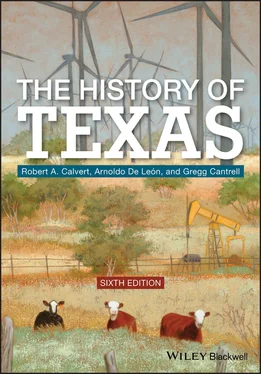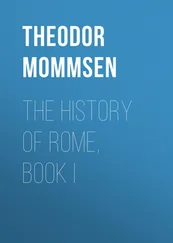The Spaniards did not revisit the Jumanos in West Texas, for they became preoccupied with increased French activity close to the Gulf of Mexico. By the early 1670s, the French were actively exploring the middle of the North American continent from their bases in Canada, and now they planned to install a string of trading stores and forts to stretch all the way from the Great Lakes to the mouth of the Mississippi. They made important headway in doing so when in 1682 René‐Robert Cavelier, Sieur de La Salle, traveled down the Mississippi and asserted title to all of the lands drained by the great river for France.
Promptly, La Salle made plans to lay more than symbolic claims to the Mississippi River basin. Intending to found a warm‐water port for the French fur trade at a site above the mouth of the Mississippi River (or perhaps, as some historians contend, plant a post there to help France capture some of the gold mines in northwestern New Spain), he left France at the head of four ships (the Aimable , the Joly , the Belle and one seized by Spanish privateers in Haiti). La Salle and his colonists, which included some women and children, arrived in the Gulf of Mexico late in 1684 (the same year that the Spaniards were active among the Jumanos in West Texas). Charting his course on the limited navigational knowledge of the seventeenth century and a reliance on hypothetically drawn maps, La Salle supposed that the Río Escondido (the modern‐day Nueces River in South Texas) was actually the celebrated Mississippi River, so in February 1685 he ended up on the Texas coast at Matagorda Bay. Following the wreck of the Aimable , his crew sailed back to France on the Joly , leaving La Salle in unknown territory with only one ship and his original 180 colonists rapidly diminishing.
On Garcitas Creek (in today’s Victoria County), La Salle founded a temporary colony. While his remaining ship (the Belle ) lay at anchor in Matagorda Bay with the supplies destined for his Mississippi venture, the Frenchman undertook an exploration in late 1685 into the Texas interior to determine the reaches of Spanish settlements. This expedition brought his party toward the Rio Grande and into the trans‐Pecos region, with disastrous results. To La Salle’s dismay, the Belle had wrecked during this absence, and to salvage something for his ambitious enterprise, the tired explorer, at the head of a seventeen‐man party, decided to turn northward in the hope of reaching Fort Saint‐Louis on the Illinois River (which he had established earlier) and from there send word of his plight to France. This gambit also proved unsuccessful, and in March 1687 La Salle died near the Trinity River at the hands of his own frustrated men, five of whom in 1688 succeeded in reaching France via Quebec. In early 1689, Karankawa Indians wiped out the survivors (about twenty‐three) at La Salle’s fledgling settlement (known erroneously in Texas history as Fort St. Louis; in actuality, there never did exist a site or garrison in Texas that went by that name), sparing only a few children whom the Spaniards later recovered.
As unimpressive as it was, the French activity in the area nonetheless alerted the Spaniards to the danger of losing Texas and prompted them to initiate the exploration of the eastern periphery of the northern frontier of New Spain. Starting in 1686 and continuing until 1690, the Crown dispatched Alonso de León (north from Nuevo León) on several expeditions, his fourth one in 1689 taking him to the remains of La Salle’s ill‐fated colony on the Garcitas. The next year, the Spaniards explored past that location and made contact with the Caddo world, long regarded by the Spaniards as “the great kingdom of the Tejas” due to legends extolling the prosperity and magnificence of the Caddos.
Actually, the Caddos of what is now East Texas (Caddo communities spread into modern‐day northwestern Louisiana) consisted of about 10,000 people; among those belonging to the Caddo nation were the Hasinai Indians, whom the Spaniards referred to as the Tejas , the Spanish rendition of the Hasinai word for friend, from which the state of Texas is named. Encircled by tribes hostile to their way of life, the Caddos stood prepared to defend their territory against any group that might try to encroach on it. The Caddos, however, confidently accepted the Europeans upon their arrival, for they saw them as potential allies and trading partners. The fact that the image of the Virgen de Guadalupe accompanied de León and the Spaniards as they approached Caddo villages helped introduce them as friends, for in the Caddo kinship gender‐based system, women symbolized peaceful intent. The Caddo leaders responded by sending parties of men, women, and children to greet the Europeans (such was their standard ritual whenever outsiders neared their communities) as their own indication of friendship. Following this reception, the Caddos invited the visitors into their village, where women (in exercise of their matrilineal roles) brought to the ceremonial courtyard foodstuffs–the fruits of their toil as agricultural laborers. The Spaniards, for their part, reciprocated with gifts such as garments, blankets, and tobacco.
With trust thus established, Caddo and Spanish expedition leaders set about discussing matters of mutual benefit. The Caddos offered no resistance when de León and Fray Damián Massanet moved to set up two missions (one of them being San Francisco de los Tejas, the first Spanish mission in Texas, 1690) among the Caddos. The Spanish perceived the Tejas (Caddos) as a particularly stable tribe that adhered to religious beliefs that recognized the existence of but one supreme being. Moreover, they ascertained that the Caddos traded widely, exchanging their bows and pottery, as well as salt and other goods, with representatives of other bands, among them the Jumanos. So many Indians from such great distances arrived in the Caddo villages in order to barter that the priests quickly envisioned the Caddo kingdom as the ideal setting for disseminating the Christian message in New Spain’s Far North.
Despite these seemingly auspicious circumstances, the Caddos did not prove to be willing converts nor indulgent hosts. For one thing, Christianity actually clashed with their religious beliefs and spiritual traditions. For another, the Spaniards had disrupted their traditional way of life. When Domingo de Terán, who had been named governor of what became the province of Texas, visited the Caddos in 1691 intending to found additional missions, his livestock indiscriminately trampled and fed upon the Caddos’ new farm harvests. This, along with the soldiers’ degrading treatment of women and imprudent overtures by the missionaries who violated Caddo protocol, made the Caddos resentful, leading the tribes’ members to retaliate by attacking the interlopers’ domesticated stock. Finally sensing hostility, the Spaniards retreated to Coahuila, leaving behind only a few missionaries to continue the work of Christianizing. But those few persons–who obviously resisted the Caddo convention that “outsiders” acceptance into their society entailed marriage–could not convince the Caddos of their good intentions, so by 1693 the Spanish had departed East Texas.
The departure proved temporary, for events from within and outwith New Spain forced a return to Caddo land. Father Francisco Hidalgo, who had worked with Massanet among the Tejas, desired to resume the work he had helped begin in East Texas. In addition, the French renewed their activity along the mouth of the Mississippi to thwart English plans to move westward from the Atlantic to the middle of the continent. When the French established themselves at Mobile Bay in 1702, then farther west at Natchitoches, in what is now western Louisiana, it gave the Spaniards cause for alarm.
Читать дальше










